
Fossil Consulting Services Vice President Scott Hommel and I had the opportunity to attend the International District Energy Association (IDEA) annual conference in beautiful Orlando, Florida. The IDEA Annual Conference is where international leaders in district energy converge to discuss the future of the industry. This year’s theme was “District Energy for Sustainable Cities.”
Cities, communities, campuses, and clusters are implementing district energy infrastructure to mitigate and prepare for the impacts of climate change, cut emissions, and provide a more robust, resilient, and connected local economy. In 2024, industry focus on de-carbonizing and fortifying energy systems will involve partnering, planning, and robust investment. This conference delivered content and conversations focusing on how we get there.
Industry leaders and vendors from around the world were present to discuss the new technologies as well as improvements on current technology and practices necessary to drive the world forward to meet both energy demand and sustainability goals.
As a company dedicated to providing site-specific training and recommendations to our clients on how to most effectively train and operate their equipment to meet cost, efficiency, and sustainability goals, Fossil Consulting Services used the opportunity to interact with multiple vendors to learn about the new and upcoming technologies and processes that our clients can use to meet current and future operational goals.
As the world continues to involve and increase the need for energy, the challenge to meet this energy demand while reducing environmental impact, and the need to evolve and adapt to new technologies efficiently is vital. This blog will highlight some of the many new technologies and services that caught our attention, and introduce you, the reader, to how these technologies can enhance your facility’s future operations.
The easiest way to improve energy output and reduce environmental output is to improve plant efficiency. For each unit of fuel saved, the associated environmental effect is reduced. This not only saves the facility money but also helps meet sustainability goals. This is probably one of the most important factors affecting energy use. From college campuses to data centers and large-scale energy producers, the challenge of meeting increasing demand and reducing the carbon footprint is great.
IDEA2024 vendors showcased several efficiency improvement efforts that can easily be implemented at any facility to provide a noticeable improvement in plant efficiency. As with any technology, the way operators use it is vital to the success of the program. FCS stands ready to provide training and qualification solutions to ensure your facility is maximizing the benefits of these technologies.
Magnus Water Chemistry – Magnus Water Chemistry is a Canadian company that specializes in developing, manufacturing, and supporting the implementation of specialized solutions for water treatment, industrial cleaning, and lubrication in metal processing, that has developed a simplified, all-organic boiler water treatment system that reduces scale formation and provides a protective coating on boiler equipment.
While they develop chemicals for many different applications, such as cooling towers and metal working, their steam boiler treatment solution, AquaFilm, utilizes organic chemicals to provide exceptional corrosion resistance by utilizing “film-forming” as the primary method of control. Organic chemical solutions are easier to work with, greener, and easier to dispose of.
To ensure the proper implementation of their chemistry solutions, they have developed an AI-assisted monitoring program. AquaAssist monitors real-time chemistry data to reduce operator learning curves, calculate and display efficiency data, and provide real-time recommendations to the operator on system adjustments, to reduce errors caused by poor (or no) sampling practices.
Application studies have shown up to a 14% increase in fuel savings from the reduction in scale formation. As many people know, as little as 1/32” of scale, a boiler has to fire approximately 100°F hotter to produce the same steam output. A 14% savings in fuel consumption results in a significant reduction from a relatively easy-to-implement change in operations!
TMCAqua – A branch of Green Swan Partners, the TMCAqua (Transport Membrane Condenser) technology recovers enthalpy (latent and sensible) and water, in the form of hot water from waste exhaust stacks. Applications range from combustion stacks to spray dryers, process dryers, and steam process stacks. Where traditional heat exchangers are not viable below 250°F, that is the ideal temperature for TMC to recover the low-grade enthalpy that would otherwise be lost to the atmosphere. Additionally, by recovering water, TMC can alleviate water considerations in regions experiencing water shortages. TMC improves process efficiency while promoting sustainability and makes Natural Gas the ideal transition fuel.
The TMCAqua low-temperature economizer recovers waste heat in a similar method that legacy economizers pre-heat feedwater for boiler feed in large-scale boilers, but also recovers moisture from the flue gas stream utilizing a nano-ceramic coating on porous fiber ceramic tubes. The recovered water is filtered during the recovery process by the tube material, similarly to the way an RO membrane treats water, and can recycle that water into the boiler feed system or utilize that water in auxiliary systems.
In a typical 1000 HP gas-fired boiler, TMCAqua can deliver 1.4 million gallons of water per year, save 16,000 MCF of Natural gas per year, improve boiler efficiency by up to 15%, and reduce carbon emissions by 1000 Tons per year. In industrial drying processes such as spray dryers, the benefits can easily be as much as 2-3 times higher than those in boiler applications.
The system is scalable, pre-assembled modules can be added to a system and can be arranged in a skid assembly to be transferred from one boiler to another. The modules are “stackable” each individual module is about 40” by 18” x 12”, and weighs approximately 90 lbs, allowing ease in installation, and can even be mobile, transferred between operating units based on the facility operating schedule.
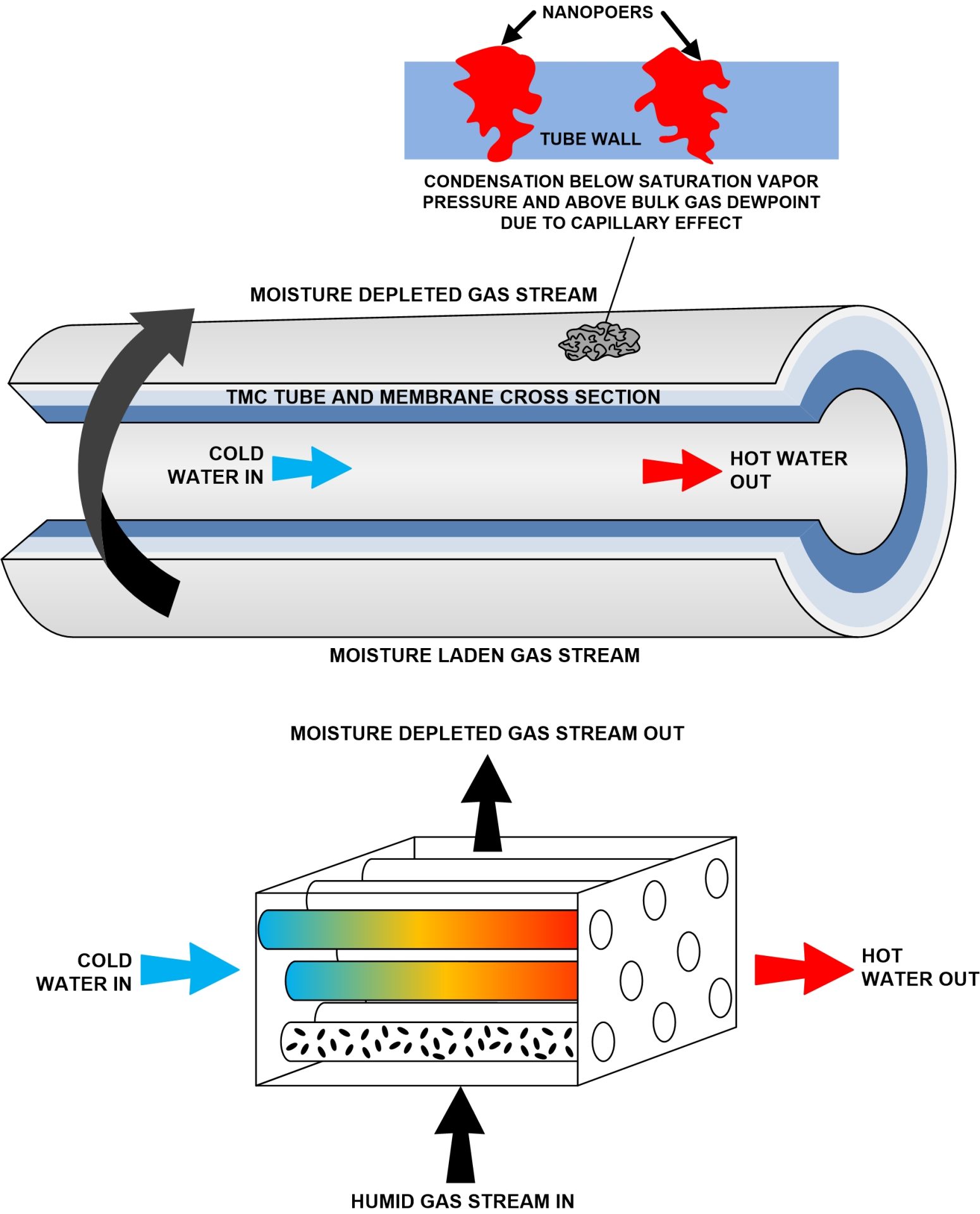
Heat Pumps were well represented at the IDEA2024 conference. Two vendors GEA and MAN Energy Solutions were onsite to showcase industrial heat pump technology. Heat Pumps are familiar to those living in temperate climates, where the air conditioning unit that cools your home in the summer utilizes the heat released in the refrigerant cycle to heat your home in the winter. In general, a heat pump is a chiller, instead of producing cool chilled water or utilizing a cold refrigerant for cooling, it captures the waste heat that is normally exhausted to the atmosphere for either heating or the production of steam.
In heating applications, the refrigerant used is often different than the standard refrigerant in a cooling system. Where chillers utilize a refrigerant like R-134, R-410, or R-1234; heat pumps often use ammonia. The ammonia is pressurized to high pressures, using multiple stages of compression based on the desired temperature output. To produce hot water for building heating, pressures of around 300 psig can be utilized. For steam production, enough to potentially power steam turbine generators, pressures of up to 600 psig are used.
While the heat pump can be utilized instead of a traditional boiler, GEA Heat Pumps stressed that clients must understand “it’s not a direct replacement for the same-size boiler. The unit should be installed to optimize operation at full capacity for efficiency.” The refrigerant cycle, and the compressors that make the cycle function, do not operate well at low load, nor do they operate efficiently when cycled excessively. This is familiar to those proficient in chiller operation, where hot-gas bypass and Variable Frequency compressors are used to prevent “surging” during low-load operation. In applications where the load may fluctuate, a buffer tank, which serves as a heat storage device, can be used to optimize operation.
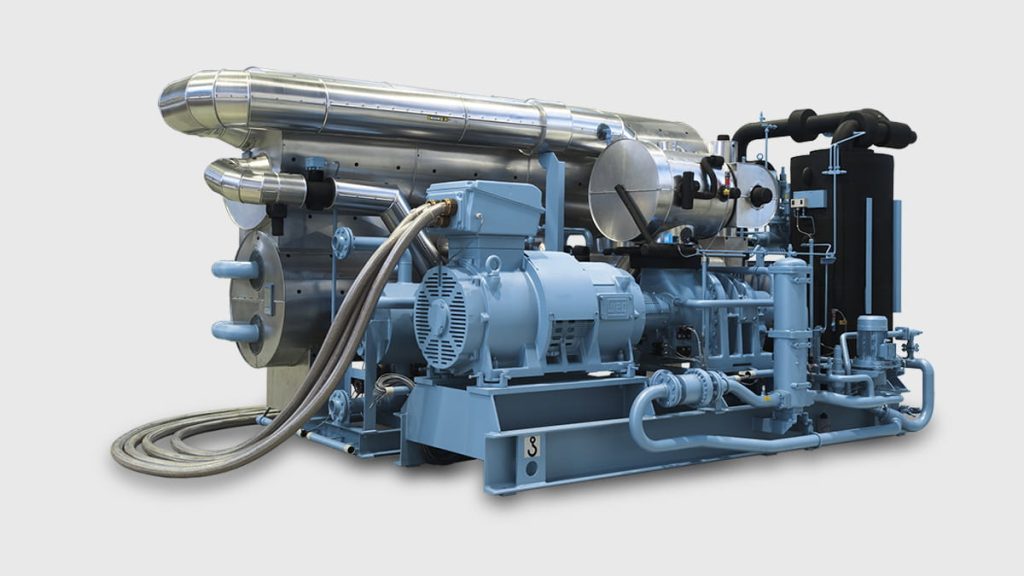
MAN Energy Solutions identified the potential for using heat pumps as a partner with data centers. Though data centers currently require multiple individual units for reliability purposes, they “are good partners, they have waste heat they don’t want that can be utilized in another application.” This could provide a potential solution to balancing renewables with grid stability or peak power or for the addition of large-scale fleet charging stations in conjunction with data center installations.
The use of ammonia presents a challenge due to the inherent dangers of the chemical. Heat Pumps utilize a small charge of ammonia refrigerant and utilize brazed-plate heat exchangers to reduce the risk of ammonia leaks. Utilizing ammonia refrigerant will require specific safety and operational training to ensure the safe and efficient operation of the system.
While GEA Heat Pumps are primarily used in heating and process steam (sanitation, etc.), heat pumps aren’t limited to small-scale operations. MAN Energy Solutions currently specializes in large-scale production, providing units that can produce up to 80 MW of electricity, with no additional fuel consumption. This is a significant energy production potential that can utilize several heat sources, with supply temperatures ranging from 32 – 302°F. Heat Pumps can also be used to utilize electricity from renewable sources, such as wind or solar, to drive the compressor, utilizing “excess” renewable energy that would otherwise not be “dispatchable,” providing grid stability.
Are you worried about the dangers of ammonia at your facility? CO2 can also be utilized as a refrigerant, which can be coupled with carbon capture equipment to further reduce emissions and utilize that captured carbon in a new process. While utilizing heat pumps to power high-pressure steam turbines may not be feasible based on current technology, utility-scale low-pressure steam turbine generators are currently in use at geothermal plants worldwide.
Too often overlooked is the effect of age and poor maintenance on efficiency. Unfortunately, proper maintenance is usually ignored until an equipment failure results in costly downtime. An unplanned outage is too late to be worried about the proper maintenance of equipment, and the cost of poor maintenance goes far beyond the loss of revenue and the cost of repair or replacement.
Motors and pumps that are improperly maintained (as well as poor electrical distribution maintenance) will cause excessive power consumption to provide the same output. This will eventually damage the motor windings or seize the shaft, depending on the root cause, but until then, it will cost you in power usage. This not only costs you money, but it increases your emissions output.
EagleHawk – Another often-ignored factor is thermal losses. Steam leaks are often easy to identify in the plant, where the effect on the environment is noticeable, but what about distribution systems? Overhead pipe racks? Even if you do a 100% visual inspection of your pipe insulation, that only identifies failed portions of insulation that are visibly apparent. If your piping is buried or runs through small tunnels, you may be missing failed insulation entirely.
EagleHawk offers proactive asset inspections to deliver insights that enable their clients to better control costs, improve safety, reduce energy waste, and extend the useful life of their assets. Their approach leverages proven technology to improve upon traditional inspection methods, which are often ineffective and expensive, resulting in the most cost-effective way to accurately assess the condition of these assets regularly.
Thermal inspection can identify leaks in large underground or above-ground distribution piping. Reducing losses and maintenance costs by pinpointing the damaged areas, which allows crews to pinpoint the repair area and disturb less infrastructure. In the event of steam and chilled water piping that is co-located in a tunnel, identifying failure of the insulation (or leaks in the piping) drastically reduces the effect on the other system, and drastically improves system efficiency.
EagleHawk‘s innovative elevateFM platform is a web-based application and mobile app, that leverages aerial data from drones or airplanes, and integrates geo-location information to allow distribution managers to view their systems in a whole new way. They can easily see their system on a map, correlate thermal location data to their as-built drawings, prioritize issues, and estimate energy losses. Dozens of distribution operators are now using elevateFM to help manage their systems.
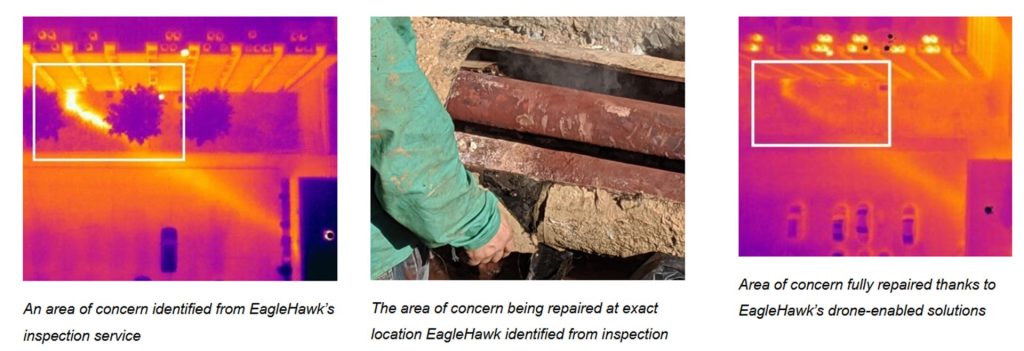
CoreChem – We already talked about chemistry, and there are a few large chemical representatives at IDEA2024, but CoreChem stood out to us. A family-owned company out of Knoxville, Tennessee, they offer a wide range of chemical services with small company customer service values. One particular product line stood out and was direct to the theme of “sustainable cities,” their bio-derived glycol line.
This exclusive line of Heat Transfer Fluids – including GlycoChill+ P-Series HD and GlycoChill+ P-Series FG – have been engineered to transform sustainability at the heart of geothermal hydronic systems. Derived from renewable, plant-based materials, these fluids provide robust antifreeze protection for a wide variety of applications, with corrosion inhibitors protecting against corrosion of both ferrous and nonferrous metals.
Their biodegradable composition ensures maximum thermal transfer capabilities with minimal environmental impact, and CORECHEM’s range of biobased heat transfer fluids also provide significant benefits in HVAC and refrigeration processes.
The use of bio-derived chemicals in hydronic systems is a small change that can have a large impact on sustainability, reducing the use of petrochemicals, and the associated environmental impact of their disposal. This is particularly useful when a system becomes contaminated, and thousands of gallons of glycol-treated water has to be removed, and either filtered, or disposed of.
Additionally, the company offers complimentary annual in-house lab testing of systems that contain their fluids. In applications where multiple independent building systems are maintained by a core group of facilities personnel, poor sampling and monitoring of glycol loops can cause inefficient operation and equipment damage. Sampling and chemical additions can result in air introduction and the need for excessive makeup water. Poor water chemistry control in building hydronic systems is a major issue that results in reduced efficiency. Reduced efficiency results in higher operating costs—and more emissions.
No discussion of sustainable cities and the world goal of reaching “Net Zero” or even “Net Negative” would be complete without highlighting new technologies that are being developed to significantly reduce or even remove carbon emissions from the process of creating heat and producing power.
Combined Heat and Power (CHP) is defined by the EPA as “an energy-efficient technology that generates electricity and captures the heat that would otherwise be wasted to provide useful thermal energy.” CHP is not a new concept. Many facilities utilize a Combined Cycle design that incorporates a Combustion Turbine (CT) and a Heat Recovery Steam Generator (HRSG). The combustion turbine generates electricity and the exhaust heat produced is sent to a HRSG to produce steam. The steam will then be sent to a Steam Turbine Generator (STG) set to generate additional electricity and any excess steam can be used for heating or process needs. See Combined Cycle Plants.
When a facility does not need the large amount of power and heat that a combustion turbine typically provides, a reciprocating engine generator set can be an alternative option.
2G Energy Systems – offers skid-mounted, continuous-duty internal combustion engine (ICE) generator sets installed in purpose-built enclosures. Each unit can range from 50 kW up to 2.5 MW and can utilize various forms of gaseous fuels, including 100% Hydrogen. Since the units are modular, they can be arranged in sets to achieve higher total power ratings as required.
2G Energy’s engines boast two huge advantages: ease of installation and ease of modification.
Ease of installation – since the units are fully assembled, skid units, they can be easily transported and installed. The end user simply needs to provide a location, power supply, and fuel supply; much like installing an emergency generator. The units can be configured to utilize a HRSG, producing process steam as well as electrical power, or can be utilized with a heat pump, like those provided by GEA or MAN.
Ease of modification – a major cost associated with changing technology is equipment becoming obsolete (a “stranded asset”). If you are currently utilizing natural gas for example, and plan to shift to hydrogen in the future, the decision to install equipment that will need heavy modification or replacement when you shift fuels is a major concern. However, with 2G’s engines, the shift in fuels simply requires a conversion kit based on the new fuel.
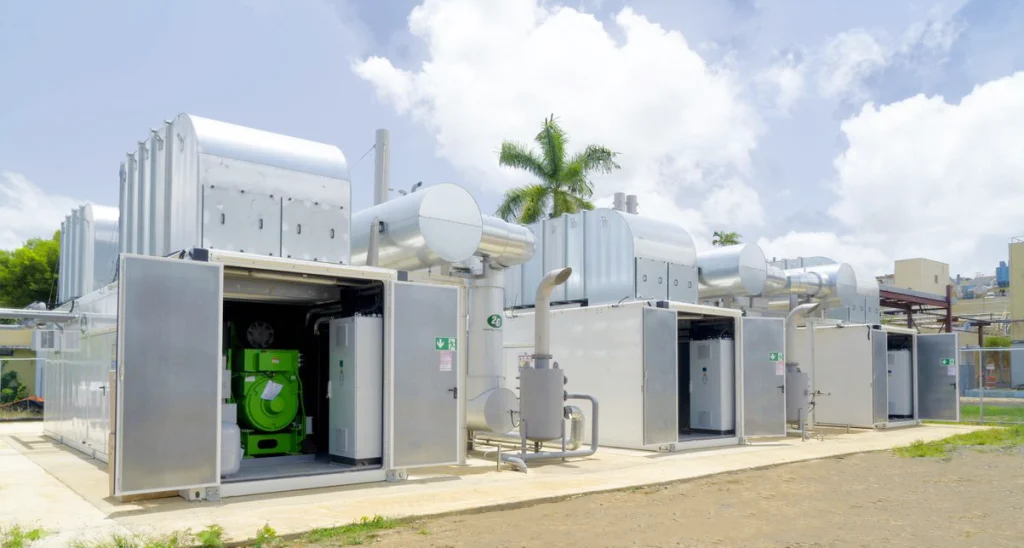
Designed to burn natural gas, biogas, Syngas, hydrogen, and propane, the engines can burn a 40% hydrogen blend without modification. To switch to 100% hydrogen (30 applications are burning 100% hydrogen currently) the “wet” components of the engine are swapped to handle the additional temperature associated with burning pure hydrogen.
While we’re on the topic of hydrogen. Many vendors are working towards modifying existing technologies (combustion turbines, boiler burners, etc., ) to burn hydrogen and hydrogen blends (with natural gas) to drastically reduce emissions. One challenge associated with burning hydrogen blends is, that while there is a reduction in carbon emissions, NOx (Oxides of Nitrogen) emissions can be increased due to the higher temperatures of combustion (What is NOx?).
Hydrogen Technologies – Has patented a breakthrough method for burning hydrogen and oxygen in a vacuum chamber to create high-temperature heat and steam with zero greenhouse gases. With the only combustion bi-product being water, the cleanH2steam Dynamic Combustion Chamber (DCC) Boiler harnesses the power of hydrogen, the most abundant element in the universe.
This “zero emissions” hydrogen boiler utilizes a closed loop system that could include an electrolyzer, (electrolysis splits water into hydrogen and oxygen gases), and then the boiler burner recombines the flammable gasses in the burner using the correct stoichiometric ratio to produce heat, similar to the method in which a legacy boiler burns natural gas. The result is complete oxidation “combustion” of the hydrogen and oxygen to form superheated steam, which then passes through the boiler tubes and boils the water in the steam drum for process use. The byproduct is no longer flue gas, but instead, the combustion bi-product (H2O) is recollected as condensate for reuse.
Check out the article Clean Steam: Greener Distillation Process, by Adam Duckett in the Chemical Engineer, dated February 2022 (login required for the full article).
One of the biggest challenges to using hydrogen as a fuel is the availability of pure hydrogen. Separating hydrogen from oxygen in water requires significant amounts of electricity. Today, commercial PEM electrolyzers take around 53 kilowatt hours (kw-h) to produce one kilogram (kg) of hydrogen, while under-development electrolyzers claim to require 42 kw-h to produce 1 kg of hydrogen. This is a significant challenge on an already stressed electric grid. In other uses, this hydrogen must be produced, then either shipped via container or pipeline, to be used at a facility, increasing cost.
Hydrogen Technologies’ boiler uses a closed-loop water system (much like a condensate system) to capture the water at the end of the cycle and feed it to the electrolyzer for splitting, to be handed back to the boiler burner. Since there will be some losses, a makeup water system will be necessary to keep the closed loop filled, but the cost and infrastructure required to utilize this technology are much less.
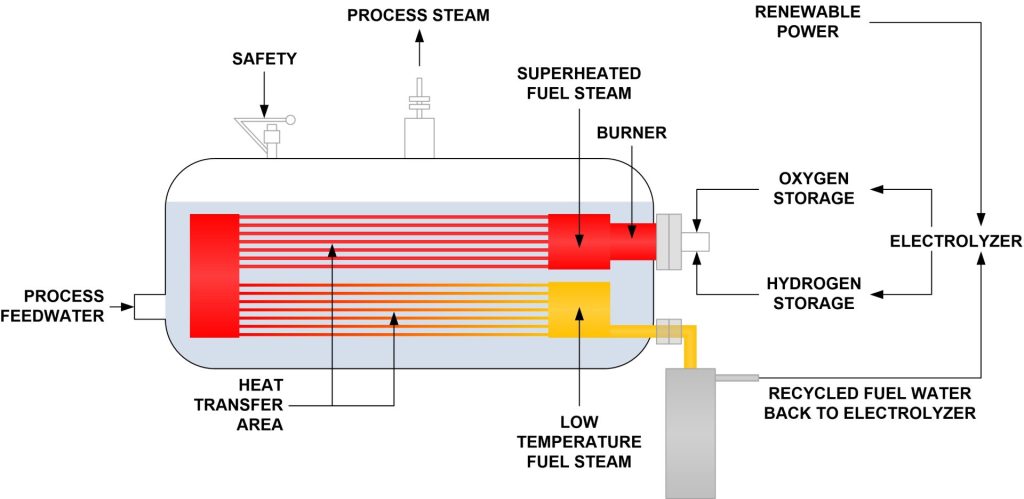
The result is that steam production is capable of replacing a fossil fuel boiler with little modification to the overall design of the traditional system. Hydrogen Technologies is partnered with established boiler and burner manufacturers, making the development much more streamlined.
The University of Colorado Boulder is piloting the hydrogen boiler beginning in 2025. The university will conduct a study on the integration of boilers into its steam header, focusing on boiler operational conditions, safety research and documentation, and the economics of boiler operating expenses. Additionally, the university will explore innovative hydrogen production and storage methods to enhance research and learning opportunities on campus.
The best technology is only effective if the application fits the need. A common factor in my discussion with vendors was the technology is only as good as the application and the operation and maintenance provided by the facility. As we transition to newer technologies and push to squeeze every ounce of use from it, solid engineering evaluation, proper installation and commissioning, and operator training and qualification will be vital to ensuring the system meets the facility’s requirements and produces the desired results.
The Onsite Energy Program, a program of the United States Department of Energy, provides technical assistance, market analysis, and best practices to help industrial facilities and other large energy users increase the adoption of onsite clean energy technologies. The program helps facilities develop and implement ways of developing and storing electrical and heat energy locally, gaining control over the availability and integration of clean energy in their processes, and helping them reach their decarbonization goals.
The Onsite Energy Program partners with industry experts and educational institutions to form “Technical Assistance Partnerships” or TAPS, to provide expertise in all regions of the United States and its territories.

Representatives from the Southeast, Midwest, and Central Onsite Energy Technical Assistance Partnerships (TAPS) attended the IDEA2024 conference to speak with attendees about the program and how they can help ensure facilities design and implement the available technologies to best suit their needs and maximize their return on investment.
The program offers assistance in three areas:
The TAPs are supported by a trio of DOE resources, including National Renewable Energy Laboratory, Oak Ridge National Laboratory, and Pacific Northwest National Laboratory, that provide subject matter expertise in onsite energy deployment.
The DOE Onsite Energy Program is a great tool to help end users navigate the shift to new technologies. Preventing ideas that sound good on paper from failing to meet their goals due to a lack of proper engineering analysis or execution.
Fossil Consulting Services began over 25 years ago to fill a void in the operations and training at power and process facilities. Though, as the name may suggest, FCS primarily provides services for fossil combustion plants, we are not limited to one technology. With backgrounds covering nuclear power, combined cycle, refrigeration plants, chemistry, and oil and gas production, our staff continuously educates ourselves in new technologies and applies over 100 years of combined engineering, operations, and maintenance knowledge to each project.
The successful implementation of new technology and the efficient operation of existing technology require much more than simply designing and installing a system. New technology requires a shift in thinking and operating skills to be efficient. A common thread with the people we talked to was “this system is similar to previous systems but not the same.” If the operators don’t understand the system theory, normal and abnormal operations, and maintenance; the system will “fail.”
Fossil Consulting Services is dedicated to staying up to date with emerging technology and training. We continue to work with clients worldwide to provide the training, procedures, and resources to ensure operators are fully qualified, prepared, and equipped to operate and maintain their equipment safely, efficiently, and effectively.
FCS has provided services for solar, hydro, thermal, and battery storage utility projects with companies like Duke Energy, Northern California Power Agency, and LG&E and KU; as well as district energy facilities for the United States Government (including The Pentagon, US Capitol, and more), University of Illinois Urbana-Champaign, University of Michigan, and The University of Chicago.